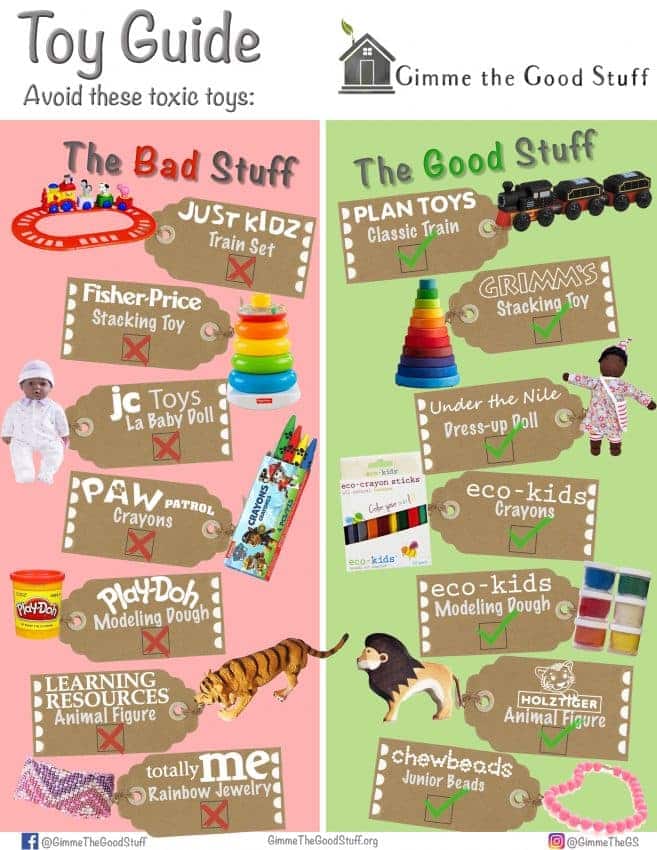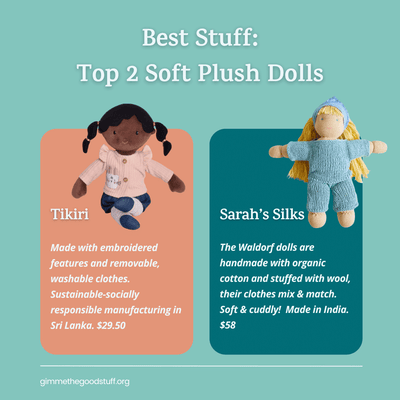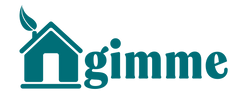This post may contain affiliate links. Please read our disclosure page.
Toys, like evvvvverything else, can introduce toxins into your home, to say nothing of the environmental impact of producing and disposing of ALL THAT plastic. I’m certainly guilty of having bought my fair share of cheap plastic toys, but it doesn’t have to be all or nothing.
While you will inevitably end up with some plastic toys in your home, you can minimize the risks to both your kids and the planet by investing in higher-quality, non-toxic toys. And, there are some happy surprises when it comes to the risks posed by toxins in toys, as you’ll soon see!
(By the way, if you are interested in finding safe, non-toxic teethers/baby toys, check out this guide. And here’s our 2024 Non-Toxic Gift Guide.)
This non-toxic toy guide will help you minimize the risks to both your kids and the planet by investing in higher-quality, non-toxic toys (within reason!).
Let’s get into it!
3 Tips for Choosing Safer, Non-Toxic Toys
If you want a truly toxin-free toy box, you will need to:
- Avoid painted wooden toys, unless they’re made in the United States or Europe or by brands you’ve vetted. Lead paint continues to show up in Chinese-made toys. Lead has been banned from toys produced in the United States, so you can be reasonably sure that toys that are made in America will be lead-free.
- Be selective with Chinese toys. Unfortunately, lead paint isn’t the only thing to fear in Chinese toys. Many Chinese-imported toys have also been found to be contaminated with brominated fire retardants (including notorious PBDEs). Although these chemicals are banned for most uses in Europe and Canada, and no longer produced in the U.S., a legal loophole allows finished toys that contain these toxins to be imported and sold here. Since more than 85% of toys are made in China, they are not easy to avoid! Being made in China doesn’t necessarily make a product Bad Stuff; in some cases, a company will be based in Europe but may have a devoted manufacturing facilities located in China (or elsewhere in Asia). In general, when companies go to the trouble to use organic cotton, real wood, water-based paints, etc., they are also the companies that maintain close control over their production facilities–wherever they are located.
- Avoid toys made of vinyl (PVC). Phthalates are typically added to PVC toys as a softening agent. You can find phthalate-free PVC, which is safer than conventional PVC, but I would still avoid it where you can. One study by Ecology Center found that 78% of toys tested contained PVC in one or more components, so again, avoiding this entirely is easier said than done.
Here’s a quick non-toxic toys cheat sheet, with a few brands that you may be wondering about:

The Worst Stuff in Toys
Some types of toys are consistently found to more toxic than others in study after study. Be especially cautious when purchasing:
Are Non-Toxic Toys Always Plastic-Free?
For the purposes of this guide, I am not going to designate any toys that are entirely made of plastic as “Good Stuff.”
That said, there are some plastics that are likely completely inert and therefore don’t present a health risk. See “The Okay Stuff” below for a bunch of safe plastic toys. Toys that use recycled safer plastics also deserve a mention.
From an environmental perspective, I would love to see us all support those companies who make high-quality wooden toys that can be passed down rather than thrown away.

Don’t see your favorite toys in any of the Good, Okay, Bad, or Sneaky categories? Comment below and let us know!
Good Stuff
Apple Park
Apple Park makes adorable plush toys made from 100% certified organic cotton and OEKO-TEX 100 toxin-free dyes. These are stuffed with a corn fiber, making them plastic-free.
Bannor Toys
Bannor offers a bunch of non-toxic toys to babies and toddlers. Everything is handmade in Iowa with wood from local lumberyards and only VOC-free paints.
Begin Again
Begin Again makes great bath toys of 100% natural rubber. They also make a range of safe wooden puzzles and other non-toxic toys.
Camden Rose
This line of wooden toys and teethers uses a beeswax/jojoba finish or a food-grade mineral oil on all of their non-toxic toys.
Dena
We love this European brand’s line of platinum silicone toys–and they are safe for the youngest kids because they are entirely non-toxic should they end up in a mouth.
Eco-Kids
Eco-Kids makes great art supplies, such as finger paint and modeling dough. Their materials include natural wax, mineral pigments, and 100% pure beeswax.
Grimm’s
This German brand also goes by Spiel & Holz, and is admittedly expensive! Still, their wooden toys are absolutely stunning. The non-toxic stains (rather than paints) means that you don’t have to worry about these toys chipping.
Haba
Haba produces most of their wooden toys in Germany, and they use nontoxic paints and finishes. Haba’s timber comes from sustainable forests from Germany, Finland, and Russia. Their paints are water-based and free of all solvents.
When Haba uses plastic, it’s polypropylene or ABS, both of which are among the safest plastics out there.
Holtztiger
Made in Germany of hard maple and beechwood, Holztiger wooden animals are colored with water-based paint and finished with a water-based sealants.
Kleynimals
I had two key-obsessed babies, and I was freaked out when I learned that not only are your set of house keys filthy, but they also often contain lead. Kleynimals 100% stainless steel toy keys are made in the USA.
Lovevery
Lovevery uses solid wood, non-toxic water-based paints, and organic cotton for almost all of their toys.
Ostheimer
Some of my favorite wooden animals are those made by Ostheimer, mostly because of simply how pretty they are. They are hand-carved in Germany, and use only non-toxic paints and natural oils for finishing.
Maple Landmark
This company’s Schoolhouse Naturals line is free of any kind of finish. Note that the other toys made by Maple Landmark do have petroleum-based lacquer and urethane finishes and would not be considered Good Stuff.
Natural Earth Paint
This is a great brand of safe, natural paints and face paints. Ingredients include simply organic corn starch and natural mineral pigments.
Petit Collage
Petit Collage makes adorable games, puzzles, wooden pull toys, instruments, and other non-toxic toys. Everything is made without PVC, and using recycled paper and vegetable inks.
Plan Toys
Plan makes all of their non-toxic toys in a sustainable factory in Thailand, where they maintain control and employ solar power.
Plan Toys wooden toys are made from natural rubberwood trees that no longer produce latex. To keep the wood pure, no fertilizer is added to the soil for at least three years prior to harvesting the wood, and the wood is strengthened via a chemical-free kiln-drying process.
Plan’s printed materials are made of recycled paper and soy ink, and assembled with zero-formaldehyde-free glue. Plan’s dyes are free of heavy metals.
Sarah’s Silks
All of Sarah’s Silks toys are made of natural, sustainable materials and inspire children to use their imagination.
Use code: GIMME10 for 10% off when you buy from Sarah’s Silks website.
Tender Leaf Toys
Like Plan, Tender Leaf Toys are made of rubberwood and painted with water-based paints. I rank them slightly below Plan because they are less transparent and overtly eco-friendly, although I can’t find anything to suggest they contain toxins.
Tikiri Toys
We love Tikiri toys for their commitment to creating safe, non-toxic, and eco-friendly products from natural rubber and organic cotton. They’re also sustainably produced, prioritizing renewable materials and biodegradable packaging to reduce their environmental impact. Tikiri is also the only non-toxic brand we’ve found that makes realisticrubber dolls, in addition toteethers,stuffies, andbath toys.
Tegu Magnetic Blocks
Tegu blocks are made of solid wood and coated with water-based paints with water-based pigments.
My kids have tons of Tegu blocks and they don’t emit any odor, and hold up well after years of play.
Uncle Goose
This brand makes my very favorite wooden letter blocks, which are handcrafted in the USA out of basswood and printed with non-toxic ink.
Under the Nile
UTN is my go-to source for soft toys because they use 100% GOTS-certified organic cotton.
Okay Stuff
Battat/B. Toys
A lot of you asked about this brand, and while their toys are made in China, they are all free of lead, phthalates, and BPA. This company is also committed to environmental sustainability in their packaging.
Bruder
Bruder vehicles, which are made in Germany, are constructed of ABS plastic, which is non-leaching and safe.
Coco Village
There is nothing overtly toxic about these toys, but their claims of non-toxicity are vague and there are no third-party tests available.
Green Toys
Green toys are among the best plastic toys you can find. They are made in America of recycled polyethylene, which is a non-leaching and safe kind of plastic.
Hape
While Hape does make their toys in China, they maintain control of their factory, and most of the materials (paints, etc.) are sourced in Germany. The wood they use comes from forests that Employ sustainable forestry practices and are FSC certified. Their paints are solvent-free.
Ikea
The Swedish giant has phased out PVC from all of their toys, but don’t offer a lot of info on the paints or glues used. Many of Ikea’s toys are made in China, although some are made in Sweden. The plastics in Ikea’s toys conform to EU laws, but Ikea does use some synthetic rubber and some lower-formaldehyde particle board.
KidKraft
Many of you have asked me about the play kitchens made by KidKraft. These kitchens are made mostly of wood, but they do employ some particle board (though it’s CARB II compliant), and some plastic.
Lamaze
This company didn’t get back to us with any certifications to back this claim up, but they assured us that none of their plush toys are treated with flame retardants.
Legos
Legos are made of ABS plastic, which is a safe, non-leaching type. This is great news for moms like me, who often feel like we are drowning in a sea of Legos! Unfortunately, Legos are not recyclable, so I still don’t consider this an eco-friendly toy.
Le Van Toys
This brand makes the prettiest dollhouses, and I was hoping I could call Le Van Toys Good Stuff. While I didn’t find anything alarming in terms of toxicity, the materials used in all Le Van Toys are not especially eco-friendly besides vague claims of “non-toxic” paints.
Magna-Tiles
Magna-Tiles are one of my boys’ favorite toys, and while they are manufactured in China, they do not contain any BPA, phthalates, PVC, or other toxic materials. The clear Magna-Tiles are made of non-leaching ABS plastic.
Spielstabil
This line is under the Haba umbrella, and produces high-quality, nontoxic, plastic toys. All Spielstabil items are made in Germany and are all free of phthalates, BPA, lead and PVC. Spielstabil products are made of food-grade ABS plastic and anything that needs to be joined together is done so using hygenic ultrasonic welding rather than glue. I am tempted to call these Good Stuff, but am sticking with my rule that nothing plastic gets categorized as such!
Steiff
While not organic or certified as non-toxic, I think Steiff is the best brand for more realistic stuffed animals. Steiff animals are made from higher-quality materials, like mohair, alpaca, cashmere, 100% cotton, and wool felt.
Bad Stuff
Alex
Alex chalk and their twist-up crayons were both found to be high in mercury in HealthyStuff studies. Their “Best Friends Bracelets” are high in arsenic, so two strikes is enough for me to call Alex Bad Stuff that should be avoided.
Barbie Dolls
Barbie Dolls are made at least in part of PVC vinyl. On the upside, Matell has ditched the solvent-based paints for Barbie’s eyes.
JC Toys
Baby dolls, like this one by JC Toys, are usually made of vinyl.
Manhattan Toys
Manhattan Toys contain polyurethane tubing.
Mash’Ems
My kids used to love Mash’Ems, and we have many of them. Unfortunately, they have been found to contain xylene.
Matchbox
Matchbox cars were found to contain “toxic chemicals” in this study.
My Little Pony
In addition to the fragrance added to My Little Pony figures, the ponies themselves are made of vinyl.
Play-Doh’s
Play-Doh’sexact formula is proprietary (which is always a bit of a red flag for me), but chemists suspect it’s a mix of innocuous ingredients like flour and not-so-good stuff, like borax, fragrance, PEG chemicals, and of course artificial colors.
TCG’s Road Racers Play Mat
TCG’s Road Racers Play Mat was found to have high levels of bromine in a study by HealthyStuff.org.
Transformers
Like Legos, Hasbro Transformers are made of ABS plastic, so I assumed they would be safe. In a recent study, Hasbro’s Transformers were found to be free of even trace amounts of heavy metals and other contaminants. However, a phone representative told a reader of ours that they are “neither BPA- nor PVC-free,” so we have to call them Sneaky Stuff.
Sneaky Stuff
Janod
Janod makes really cute European wooden toys, and while they use water-based paints, the wood is plywood, which likely means formaldehyde.
Melissa & Doug
Melissa & Doug is sold absolutely everywhere, and my kids have a lot of their toys. Unfortunately, Melissa & Doug toys are all made in China, and some of them have been found to be contaminated with heavy metals.
Schleich Animal Figurines
We own a lot of Schleich animal figurines, because I assumed they would be safer than the cheap alternatives (it’s a German company and the animals are beautiful and high-quality, the paint never chips, and they don’t smell toxic). Unfortunately, Schleich figurines are made of PVC, and they only mention being free of the phthalates that are banned in children’s toys.
Playmobil
I was disappointed to learn on Healthystuff.org that Playmobil is contaminated by a range of toxins and heavy metals. These were among my favorite toys when I was a child, and I assumed they would be a safe plastic choice until my research told me otherwise.
Note: This article contains affiliate links or sponsored content, which means that if you make a purchase, we may earn a commission. We only recommend products that meet our strict standards for non-toxicity and that we use (or want to use!) ourselves. Thank you so much for supporting the brands that make Good Stuff!
Tags:Gift Guides,
Kid Stuff,
Pregnancy & Parenting

































































